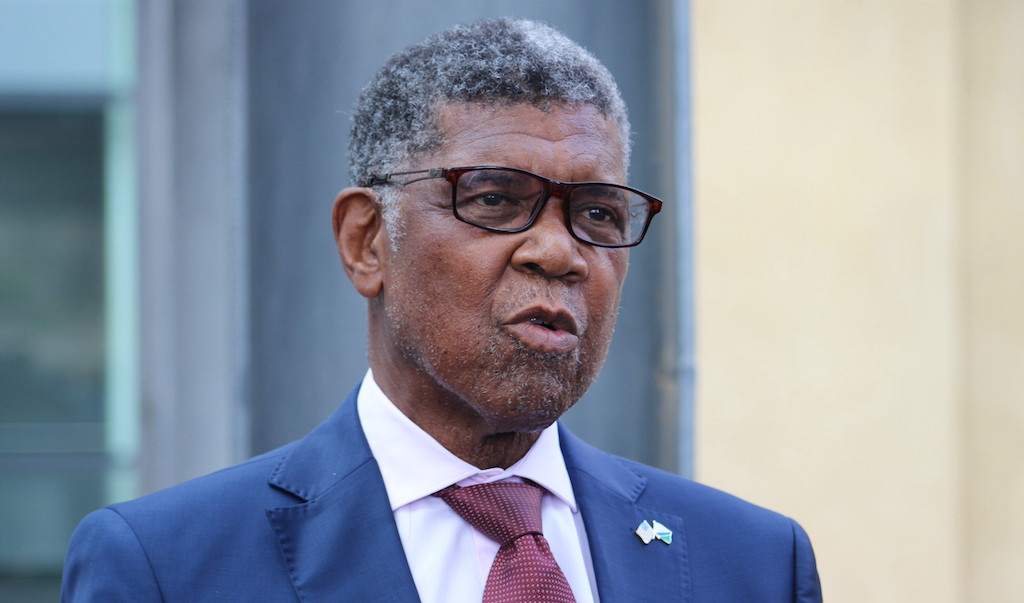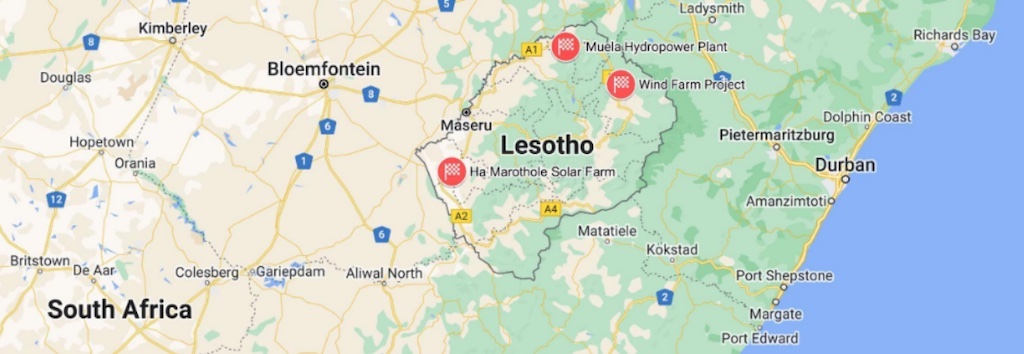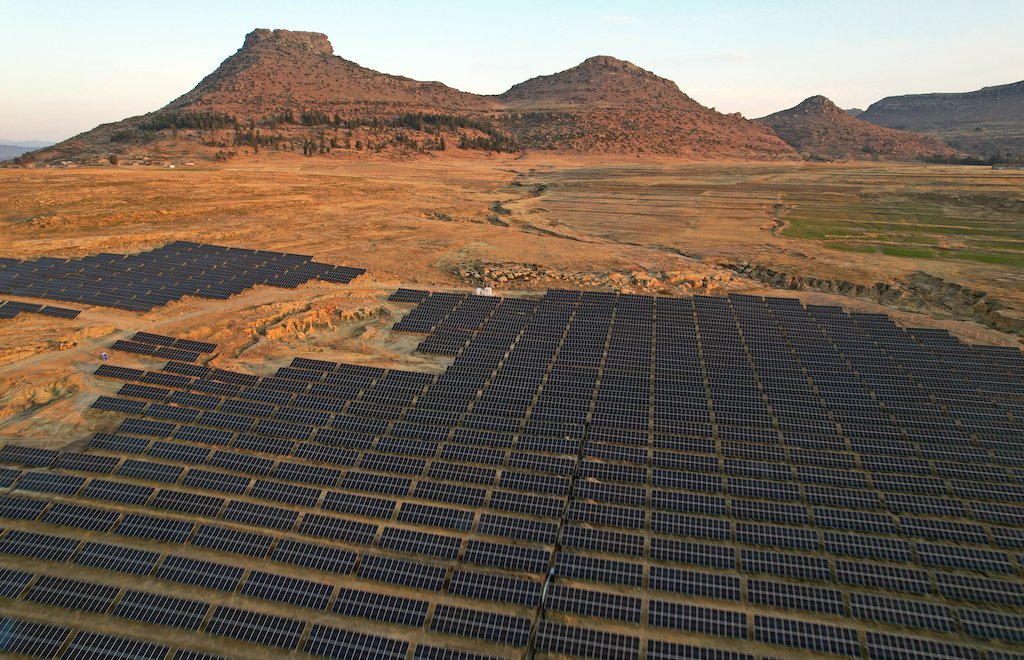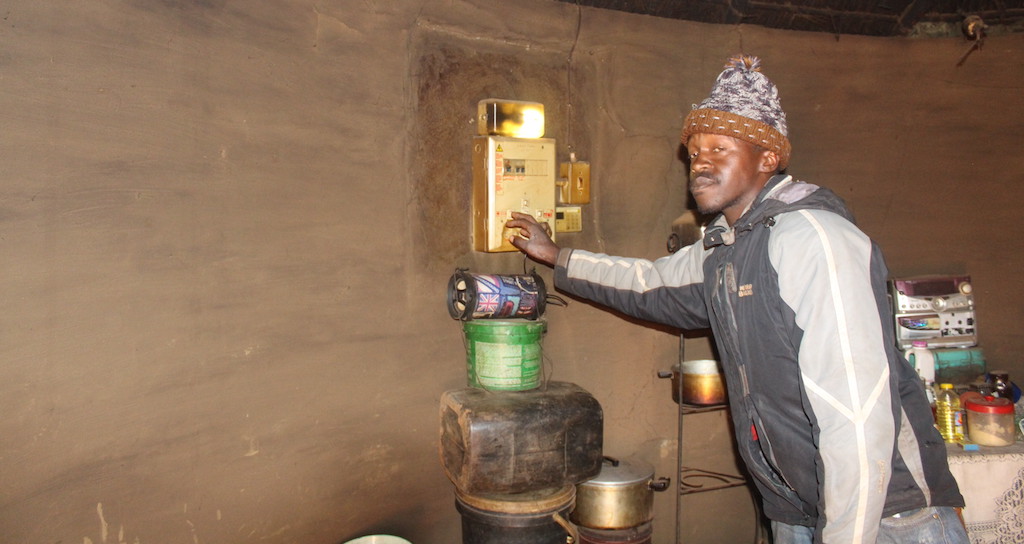
16 Sep Gone with the wind: Lesotho’s $15-billion energy pipedream
A wind farm hailed as Africa’s largest renewable energy project and the solution to Lesotho’s hefty electricity costs has ground to a halt. Sechaba Mokhethi investigates why

Monyane Moleleki was minister of natural resources when the deal was conceived. Photo © Sechaba Mokhethi
A $15-billion wind farm project that would have given Lesotho bragging rights to Africa’s largest renewable energy project, slashed electricity prices and created thousands of jobs has vanished from the country’s planned projects, leaving behind unanswered questions and politicians who don’t remember the detail.
The project was designed to increase the local energy production from 73 megawatts (MW) to 6,073MW, and would have meant the Southern African country could stop importation of expensive electricity from South Africa and Mozambique.
All traces of the project, which was conceived by the South African firm Harrison & White Investments and intended to be constructed in Mokhotlong district, have vanished. Politicians do not seem to have any explanation for this, or any knowledge that the government had a stake in the company earmarked for its construction.

The wind farm was intended to be constructed in Mokhotlong district, in the north-west of the mountainous country. Map supplied
Government collaboration
In 2011 Harrison & White Investments announced its collaboration with the Lesotho government on the $15-billion (then R110-billion) wind farm project, which would have been one of the largest of its kind in the world, according to IOL News.
Construction was to be undertaken by Breeze Power (Pty) Ltd, a little-known consortium in Lesotho reportedly made up of 25% shares held by the Lesotho government and 75% by Harrison & White, Chinese and other foreign investors. Reports at the time indicated the project would include 4,000 wind turbines in the highlands of the mountainous country.
However, no one seems willing to own up to knowing about the government’s alleged stake in Breeze Power – not even Monyane Moleleki, who was minister of natural resources at the time and was closely linked to Harris & White’s owners.
“It is my first time hearing that the government had a stake in Breeze Power… I never committed the government to this project,” Moleleki said in a recent interview.
The project appears to have ground to a halt when Moleleki left the ministry and was succeeded by Timothy Thahane, who became minister of energy in 2012 following the division of the ministry of natural resources into two parts.
Thahane now questions Breeze Power’s credentials, saying they were being promoted by Moleleki. “I only heard of Breeze Power and I know Moss [Leoka, the executive director] too, but when you look behind, there is no track record, no technical substance, just lies. They were a fly-by-night and I could not waste my time with them,” he said.
Moss Leoka, the executive director of both Harrison & White and Breeze Power, indicates that Moleleki’s role in the project was bigger than he is admitting.
“Harrison & White and the government had signed a Memorandum of Agreement [MOA]. Minister Monyane Moleleki had signed the MOA on behalf of the government. The signing of the MOA followed the project’s approval by the Cabinet,” Leoka said in response to questions.
Although he could not share a copy of the MOA, Leoka said Breeze Power’s shareholders were “Harrison & White Investments with 90% shareholding and the Government of Lesotho with 10% shareholding. The government had the option to acquire a further 15% stake in the project at a price to be mutually agreed by the shareholders.”
Presented with these contradictions, Moleleki responded: “We might have had an MOA, but it’s not a contract. We are talking about things which happened 12 years ago and I can’t remember them.”

The 30MW solar farm under construction at Ha Ramarothole in Mafeteng was also embroiled in controversy when the then Minister of Energy and Meteorology, Mokoto Hloaele, was accused of taking bribes from contractors to inflate the cost of the project. The ministry was under the control of the Alliance of Democrats led by Monyane Moleleki. Hloaele denied the allegations. Photo: Sechaba Mokhethi
Wind turbines
Breeze Power was reported in 2011 to have signed an agreement with a Chinese technology partner, Ming Yang Wind Power Ltd, for the manufacture of wind turbine components to be made in factories in South Africa and Lesotho.
“We had chosen Ming Yang to be our partners due to their experience in developing wind power projects in the high mountains of north western China,” Leoka explained recently. “We took two representatives from the Lesotho Ministry of Energy with us on a site visit to one of their projects high up the mountains. Sadly, a few months later they pulled out of the project.”
The Lesotho companies’ register records that Moya Eco Power (Pty) Limited, a South African firm, is the sole owner of Breeze Power. The register indicates Breeze Power was incorporated in Lesotho in July 2010, with its registered office listed as a room in one of the hotels in Maseru.
Asked to explain the discrepancy between the information on the MOA and that on Breeze Power’s registration records, Leoka said after new companies are registered it is not uncommon for some details to be changed later. “[For] example, when Breeze Power was registered we had not yet appointed a board of directors, so a few names had to be used so that the company could be registered.”
Moleleki admits having had several meetings with Harrison & White representatives, but denies ever committing the government to the project.
In 2015 his party came back into power. The following year a letter signed by Selibe Mochoboroane, who was then minister of energy, was sent to Regions of Climate Action (R20) – a non-profit organisation that aims to bring together local authorities, technology providers and investors in their quest to promote renewable energy projects – introducing Breeze Power as the identified source of funding and also an engineering, procurement and construction contractor for this project.
Now the minister of development planning, responsible for approving all government projects, Mochoboroane said recently that the wind farm project is no longer in the government pipeline.
He said his signature on the letter to R20 might have been forged. Part of it reads: “We welcome R20’s initiative to work alongside governments… in accelerating the emergence of low-carbon climate-resilient infrastructure projects. We hereby mandate R20 to explore opportunities for the development of such projects within the Kingdom of Lesotho, specifically… wind farming.”
Mochoboroane said the signature “looks like mine. But one thing I am sure of is that I am not the one who wrote that letter, even if it was signed by myself. I am just so clueless about it. Maybe its proponents found a way to make me pass this letter on their behalf.”
Polluting energy
At the time the project was being planned, Moleleki in his capacity as minister of natural resources hailed the initiative, saying it would help Lesotho achieve “developing country status”.
“I was very enthusiastic about the project, so much so that I talked about it on the BBC,” he said in a recent interview.
He said South Africa has long supplied Lesotho with “what is probably the cheapest energy, yet very polluting”, and he had hoped to change that situation with this project by creating renewable green power and exporting it to South Africa. “It was an exciting, mouth-watering prospect,” Moleleki added.
Moleleki said during the interview that, for almost a year, he had met Leoka on several occasions as a minister: “We met in Gauteng. They came to Lesotho Sun [Hotel] and to my office. He was a tall, very articulate and convincing gentleman… he was a likeable fellow.”
However, he said he had no knowledge about Breeze Power’s establishment despite his meetings with Leoka and vowed he had not committed the government to the consortium. “Because, at the end of the day, the ministry of development planning was the one responsible for its approval,” he said.

A wind farm in South Africa’s Western Cape province. Monyane Moleleki described the dream of creating renewable green power in Lesotho and exporting it to South Africa as ‘an exciting, mouth-watering prospect’. Photo © Tholakele Nene
Harrison & White
Lee-Ann Louverdis, a spokesperson for Breeze Power, told IOL News in 2011 the plan for Lesotho to build the world’s largest renewable energy project would be made up of 80% Chinese debt and 20% equity. Lesotho would contribute $250-million and Harrison & White would provide the balance, according to the report.
Investigations show that Moss Leoka, who was instrumental in setting up Breeze Power in Lesotho, is a shareholder of Harrison & White and he was at that time doubling as chief executive officer of Moya Eco Power in South Africa.
While it’s unclear what state Harrison & White’s finances were in at the time of the announcement, court records show that it started business rescue proceedings in 2013 and was finally liquidated in 2017.
“Up to the time that the project stopped, Harrison & White had spent over R40-million of its own money on the project,” Leoka said recently. “Beyond its role as a shareholder and contributor of the land, the government did not have much role to play.”
According to former minister Monyane Moleleki, the topic of the project’s funding was never discussed during his tenure, despite the fact that reports in which he was interviewed at the time stated that the project’s main funding would be sourced from Chinese loans.
The office of public debt management, responsible for all loans taken by the Lesotho government, is in the dark about these reported plans.
“I don’t know anything about the wind farm project… Nothing has even been hinted at all,” said the director of public debt management, Khotso Moleleki, who is related to Monyane Moleleki. He stressed that no government loan could be taken “without our involvement”.
All of this transpired ahead of the 2012 national elections, which Monyane Moleleki’s then-Democratic Congress party ultimately lost.
Moleleki now says he can’t remember his role in the meetings with Harris & White representatives, which stretched for more than six months. He also denies the statements about his involvement made by Breeze Power: “I was giving them moral support. I was excited about the project, but it fizzled away.”

The wind project stalled when Harrison & White Investments was liquidated as the project depended on the company to fund it until signing a power purchase agreement with Eskom for the import of electricity from Lesotho. Pamphlet supplied
Broke investor
After the Democratic Congress regained control of the government in 2015, Breeze Power noted on the companies’ register that it started business in March of that year doing electric power generation, transmission, and distribution.
It was under this administration that the letter with Mochoboroane’s signature was written to the Regions of Climate Action (R20) secretariat introducing the wind farm project.
In 2015/6, the same year that Mochoboroane allegedly introduced Breeze Power as a source of funding for the project, its mother company, Harrison & White, was already sinking in over R70-million debt and facing liquidation in South Africa.
According to court papers, this debt was made up of R55,031.90 owed to Cranes Direct CC; R55,404,291.57 owed to Firstrand Bank Limited; R15,337,921.21 owed to the South African Revenue Services; and R81,491.84 owed to Teemane Cranes (Pty) Ltd.
The liquidators’ report, as presented to the Benoni Magistrate’s Court on February 21 2018, states that Harrison & White’s financial problems had started earlier and on July 4 2013 the company commenced business rescue proceedings, which were dependent on a substantial investment from an unnamed offshore investor that never materialised.
“What is clear is that the company [Harrison & White] invested in a number of projects in an attempt to broaden its business operations. Most of these projects were unsuccessful and resulted in additional pressure on the company’s cash resources,” noted the report.
According to Leoka, the project stalled when Harrison & White Investments was liquidated as the project depended on the company to fund it until signing a power purchase agreement with Eskom for the import of electricity from Lesotho.
“The unfortunate liquidation of Harrison & White happened just before the project could reach financial closure. Financial institutions and investors are typically averse to funding projects at the upstream stage. They prefer to come in post feasibility,” Leoka said.
“Developing a wind power project such as Breeze Power was a massive task, but it was not rocket science,” he said. “In the last 10 years more than a dozen wind power projects have been developed in South Africa by local companies, none of which had any experience in this field. They didn’t need to have had any. They engaged engineering, procurement and construction contractors who had the requisite expertise to deliver their projects as going concerns.”

Lira Moeko (29) lives with his mother in a one-room thatched shack in Nokong, a remote village in the Mosalemane constituency. Since being connected to the grid in 2020, the household has used electricity only for lighting. ‘I’ve always wished I could use an electric stove, but alas… I am forced to cook on a traditional firewood stove,’ he says. Photo © Sechaba Mokhethi
Power pipedream
Lesotho’s 72MW Muela Hydropower Plant has supplied only 60% of the country’s energy needs over the years, necessitating imports of the remaining 40% from non-renewable coal-fired sources in South Africa and Mozambique.
The Lesotho Electricity Company says the landlocked country pays 10 times more to its neighbour than it pays for electricity from the local hydropower station, adding an additional cost for rural communities living on shoe-string budgets.
South Africa’s power utility Eskom was the intended recipient of power from the Lesotho wind project, according to reports at the time, although no agreement to purchase had been signed.
The Global Data report indicates that the project was envisaged to operate on 4,000 wind turbines that would be constructed in multiple phases over 10 to 15 years. It was anticipated that the farm would generate 6,000MW of wind power before 2021.
“The first phase includes a 150MW power plant, the second phase includes a 300MW power plant, and the third phase includes a 600MW power plant. Further phases of the project are not determined yet,” notes the report.
All this was just a pipedream as a recent visit to Mokhotlong discovered that the remote wind sensing masts, which Moleleki said were erected by Moss Leoka’s company and controlled in Canada, were no longer there, allegedly vandalised and stolen.
The area principal chief, Qetho Sekonyela, said the residents knew only that the masts were used for wind energy testing, but he did not have further details as they were erected during the reign of his late father.
Sechaba Mokhethi is managing director of MNN Centre for Investigative Journalism in Lesotho. This investigation was completed with the support of the Oxpeckers Investigative Environmental Journalism #PowerTracker project and the Centre for Investigative Journalism’s Open Climate Reporting Initiative. It was co-published by the MNN Centre for Investigative Journalism here, and by the Mail & Guardian here
